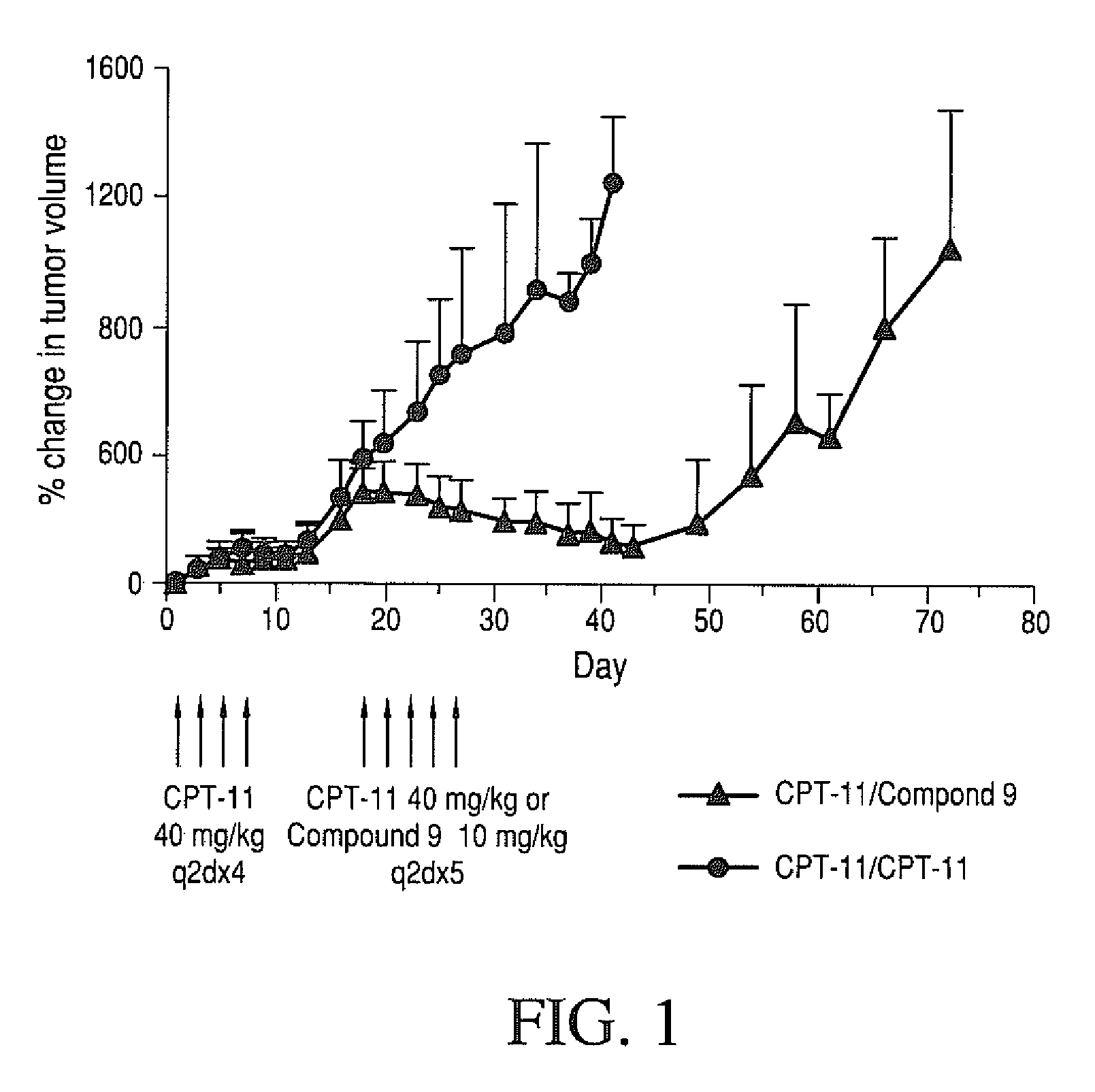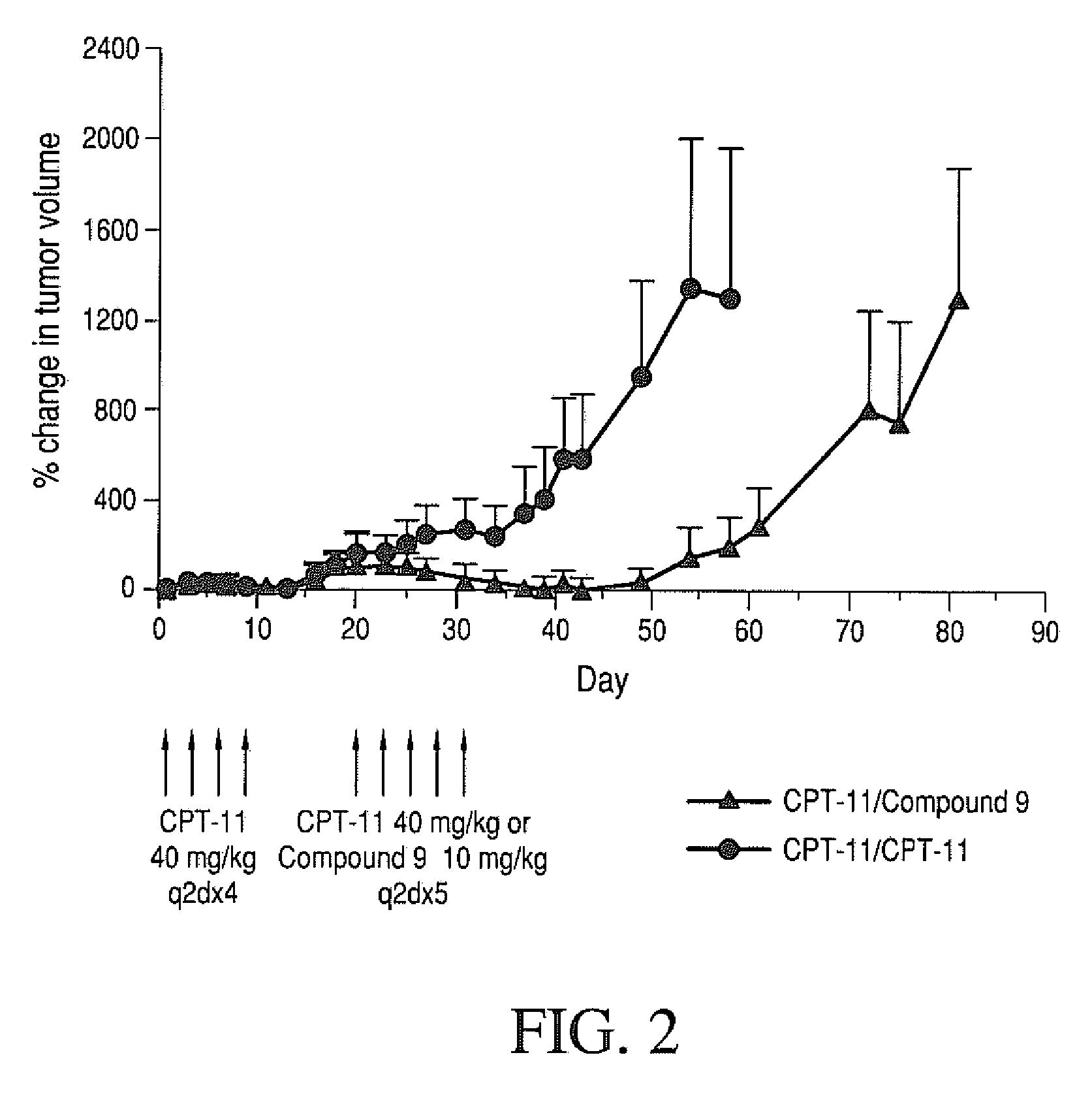Treatment of resistant or refractory cancers with multi-arm polymeric conjugates of 7-ethyl-10-hydroxycamptothecin
a cancer and drug resistance technology, applied in the field of resistant or refractory cancers, can solve the problems of drug resistance and other cancers that cannot respond to therapies, and achieve the effect of reducing toxicity and/or resistan
- Summary
- Abstract
- Description
- Claims
- Application Information
AI Technical Summary
Benefits of technology
Problems solved by technology
Method used
Image
Examples
example 1
Therapeutic Efficacy of Four-arm PEG-Gly-(7-ethyl-10-hydroxy-camptothecin) in Human Colorectal Tumor Xenografted Mice Refractory to CPT-11
[0246]Therapeutic efficacy of four-arm PET-Gly-(7-ethyl-10-hydroxycamptothecin) against a refractory human HT-29 colorectal tumor grown in nude mice was determined. Human HT-29 colorectal tumors were established in nude mice by subcutaneous injection of 1×106 cells / mouse into a right auxiliary flank. When tumors reached an average volume of 100 mm3, mice were treated with CPT-11 (40 mg / kg / dose; q2d×4). Mice were monitored for tumor growth. On day 15, mice with tumors that did not respond to CPT-11 therapy (tumor volume ≧3× initial tumor volume at the start of CPT-11 therapy) were considered CPT-11 refractory. These mice were selected, randomized and divided into two groups. One group was treated with MTD of CPT-11 (40 mg / kg / dose; q2d×5) and the other group was treated with MTD of four-arm 40KPEG-Gly-(7-ethyl-10-hydroxycamptothecin) (compound 9) (1...
example 2
Therapeutic Efficacy of Four-arm PEG-Gly-(7-ethyl-10-hydroxy-camptothecin) in Human Colorectal Tumor Xenografted Mice Refractory to CPT-11 in the Second Round Treatment
[0249]Human HT-29 colorectal tumors were established in nude mice by subcutaneous injection of 1×106 cells / mouse into a right auxiliary flank. When tumors reached an average volume of 100 mm3, mice were treated with CPT-11 (40 mg / kg / dose; q2d×4). Mice were monitored for tumor growth. On day 15, mice that responded to CPT-11 therapy (mice that had tumor volumes 40KPEG-Gly-(7-ethyl-10-hydroxycamptothecin) (10 mg / kg / dose q2d×5) starting day 16. The drugs were administered intravenously via the tail vein.
[0250]The results are set forth in FIG. 2. On day 54, in mice treated with CPT-11, tumor volume increased by 1298% compared to day 1. Mice treated with four-arm 40KPEG-Gly-(7-ethyl-10-hydroxycamptothecin) had tumor volume moderately increased by 193%. Additionally, as of day 61, 60% animals were sacrificed in CPT-11 treat...
example 3
In vitro Cytotoxicity of Four-arm PEG-Gly-(7-ethyl-10-hydroxy-camptothecin) in the CPT Refractory Cell Line
[0251]CPT-refractory cell line (CEM / C2) and the corresponding non-refractory parent cell line (CEM) were treated with PEG-Gly-(7-ethyl-10-hydroxycamptothecin), 7-ethyl-10-hydroxycamptothecin, and CPT-11. The CEM / C2 and CEM were obtained from NCI. The CEM cell lines are acute lymphoblastic leukemia cell lines. The in vitro cytotoxicity of each drug was determined using a MTS assay. Briefly, cells were placed in 96-well plates (8×104 per well) and then treated with serial dilutions of four-arm 40KPEG-Gly-(7-ethyl-10-hydroxycamptothecin) (compound 9), CPT or free 7-ethyl-10-hydroxycamptothecin for 2 days at 37° C. At the end of the incubation, MTS dye was added and incubated for 2 to 3 hours at 37° C. and formation of a colored product (formazan) was measured at 490 nm. The % viability at each drug concentration was calculated as [OD test samples−background] / [OD controls (no treat...
PUM
| Property | Measurement | Unit |
|---|---|---|
| volume | aaaaa | aaaaa |
| refractory | aaaaa | aaaaa |
| weight | aaaaa | aaaaa |
Abstract
Description
Claims
Application Information
 Login to View More
Login to View More - Generate Ideas
- Intellectual Property
- Life Sciences
- Materials
- Tech Scout
- Unparalleled Data Quality
- Higher Quality Content
- 60% Fewer Hallucinations
Browse by: Latest US Patents, China's latest patents, Technical Efficacy Thesaurus, Application Domain, Technology Topic, Popular Technical Reports.
© 2025 PatSnap. All rights reserved.Legal|Privacy policy|Modern Slavery Act Transparency Statement|Sitemap|About US| Contact US: help@patsnap.com



